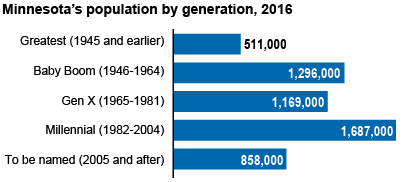by Richard Chase
Reporting social and economic trends about the East Metro suburbs was one of my first projects at Wilder Research about 30 years ago. The graphs were all hand-drawn, and their messages clear. All the trends were up.
As one of the newest members of the Minnesota Compass team, I looked across the topic areas on the Compass website to draw out three sets of interacting trends and data points – demographic, economic, social – that touch on issues of race and region. Each of these issues would be elucidated by data disaggregation or separation into more specific cultural groups or geographic sites as that data become more available on the Compass website during 2018.
Demographic trends: To what extent will generations cooperate and compete?
Three age-related trends are unfolding at the same time among the 5.5 million people in Minnesota.

Millennials are the largest age group in Minnesota, numbering about 1.7 million and making up about 31 percent of the population. These teen to mid-30-year-olds now outnumber their parents' baby boom generation, who make up 23 percent of the population. This generational shift, marked by growing diversity and lower standards of living, may be driving a more flexible and inclusive workplace.
The number of Minnesotans age 65 years and older is projected to increase by about half a million people – to 1.3 million or a fifth of the state population – by 2030. As this group ages, it poses challenges and opportunities depending on the extent to which these older adults stay healthy and active. Warnings abound about the widespread potential drain on our workforce, health care and social service systems, and civic institutions as more people retire and more complex and costly health conditions increase with age. On the other hand, a sizable portion of the boomers have the wealth and health to lead active lifestyles as consumers and community volunteers.
Our state's youngest children (age 0-4) make up about 6 percent of the population. About one in three young children is of color and about one in five is a child of an immigrant.
The success of Minnesota's future depends on supporting health, educational, and economic equity among all families and communities in Minnesota. Without careful consideration, these generations might not simply coexist, but could be on a collision course towards social strains and financial burdens.
Economic trends: To what extent are opportunities and growth widespread or unequal?
Minnesota is projected to have thousands of unfilled job openings by 2024. But where will they be located, how much will they pay, and who will be ready to fill them?
Overall job growth has bounced back in the past 10 years, with the number of jobs statewide approaching 2.9 million. In the Twin Cities 7-county region, the suburbs have seen the largest job gains, with more limited job growth within Minneapolis and especially St. Paul. Throughout the state, job growth in the Central and West Central regions has outpaced other regions.
While overall job growth is a positive trend, low-wage jobs top the list of occupations expected to have the most openings in the next ten years, according to the Minnesota Department of Employment and Economic Development. These include jobs in health care as personal care and home health aides, needed to assist the growing population of frail older adults. Higher-paying health-related jobs, such as registered nurses and nursing assistants are also growing fast.
In order to retain our state's economic competitiveness and to maintain our high quality of life, we need to invest in our future workforce -- our children. The early years set the stage for future challenge or success and are arguably the most crucial for a child's development. While overall poverty rates have started to drop in the past few years to under 10 percent, poverty is highest among young children under age 5 (14%). Poverty rates are particularly high among young African American and American Indian children.
For all Minnesotans to benefit from our robust economy, local and community-led economic development, regional transit solutions, and investments starting in early childhood must be supported.
Social connectedness trends: To what extent is the glass full or empty?
In these times of growing awareness and concern about the lifelong negative consequences of historical trauma, adverse childhood experiences, generational poverty, and toxic stress, looking at Minnesota through a strengths-based lens reveals some signs of hope to build upon.
For example, we know that:
- Sixty percent of Minnesota students report feeling connected to a caring adult in their community, such as a teacher, coach, mentor, or youth worker. Levels of connection are similar across racial groups and regions of the state. Connections to a caring adult are a strong guard against risky behavior and a link to resilience and future success.

- Among school-age children in Minnesota, 86 percent participate in arts or culture activities. This includes taking an art or music class, attending a concert, seeing a play, or visiting a museum.
- Statewide, 42 percent of residents age 65-74 and about a quarter of people age 75+ volunteer their time and talents to organizations each year. The overall state average is 36 percent.
Safe, stable, and trusting relationships hold communities together, support health and well-being, and help people thrive throughout the life course.